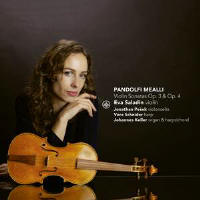Texte paru dans: / Appeared in: |
|
|
Outil de traduction |
|
|
This is the second solo album from violinist Eva Saladin. Her first (Glossa) explored 17th-century violin sonatas from the so-called Di Martinelli Manuscript held at the Catholic University of Leuven. Here she sticks to a similar remit but focuses on a single composer, Giovanni Antonio Pandolfi Mealli. Pandolfi Mealli was born in 1624 and lived in Venice (his brother was a castrato at San Marco under Monteverdi). He ended up in Innsbruck as a member of the Hofkapelle, and it’s likely he died in Madrid in 1687. Andrew Manze, in the booklet notes for his 1999 release, jokingly wonders whether the composer was ‘invented by a mischievous musicologist one wet Wednesday’ – such is the scant state of what else is known about him.
The playing is all very solid. Saladin is impressively in tune, clear and confident. Her technique is assured and the ensemble is reliably together. But the overall effect, unfortunately, is one of blandness. Interest remains on a micro level – a tremolo ornament here, a flashy Lombard there. But these sonatas require colour on a much larger scale. I would forgive an unfamiliar listener for not knowing where one sonata ends and another begins. Mealli’s music is wacky. Saladin does not take the drama or characterisation nearly far enough, and the effect is somewhat limp.
Compare Rachel Podger’s interpretation of La Vinciolina, Op 4 No 6 (‘Perla Barroca’ – Channel Classics, 10/14). This writhes with character, sinuous in seeming spontaneity. Podger’s playing is deliciously unpredictable, and the sweetness of the second section is, well, delicious. Listen to Saladin’s account after Podger’s, and the assuredness of her sound reveals itself as opacity. Or take La Cesta, Op 3 No 2. Manze and friends, like Saladin, choose to open their Pandolfi Mealli album with this sonata. Manze’s frailty works into a muscly groan: he conjures a sense that the music has a life of its own, as if it’s working out its mysteries through ornamentation and diminution. And it’s difficult to imagine more excitingly sweaty continuo-playing than that provided by Richard Egarr, in this sonata and throughout the disc.
Against these accounts, Saladin’s performances do not quite land. Of course, these are unfair comparisons for a violinist at the start of their recording career. But those are the risks for taking on music already recorded by Baroque violin royalty. Timbrally, however, there are some interesting things happening with the organ here provided by Johannes Keller. |
|




